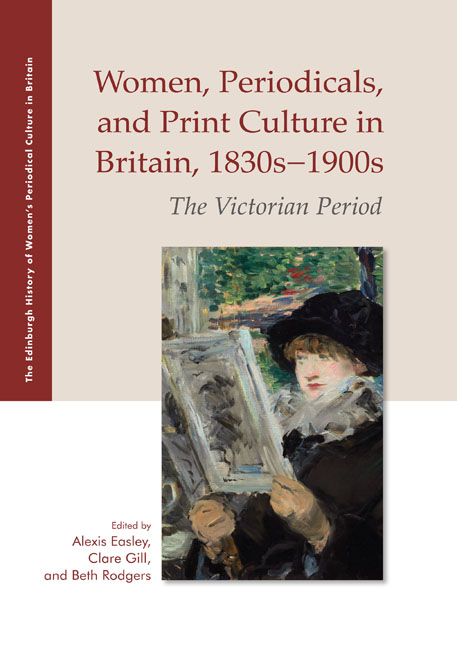Book contents
- Frontmatter
- Contents
- List of Illustrations
- Acknowledgments
- Introduction: Women, Periodicals, and Print Culture in the Victorian Period
- Part I (Re)Imagining Domestic Life
- (Re)Imagining Domestic Life: Introduction
- 1 The Rise and Rise of the Domestic Magazine: Femininity at Home in Popular Periodicals
- 2 Regulating Servants in Victorian Women's Print Media
- 3 Women Editors’ Transnational Networks in the Englishwoman's Domestic Magazine and Myra's Journal
- 4 Women and Family Health in the Mid-Victorian Family Magazine
- 5 Negotiating Female Identity in Nineteenth-Century Ireland
- 6 Women and the Welsh Newspaper Press: The Cambrian News and the Western Mail, 1870–1895
- Part II Constructing Modern Girls and Young Women
- Part III Women and Visual Culture
- Part IV Making Space for Women
- Part V Constructing Women Readers and Writers
- Part VI Intervening in Political Debates
- Notes on Contributors
- Index
- Plate section
3 - Women Editors’ Transnational Networks in the Englishwoman's Domestic Magazine and Myra's Journal
from Part I - (Re)Imagining Domestic Life
Published online by Cambridge University Press: 25 October 2019
- Frontmatter
- Contents
- List of Illustrations
- Acknowledgments
- Introduction: Women, Periodicals, and Print Culture in the Victorian Period
- Part I (Re)Imagining Domestic Life
- (Re)Imagining Domestic Life: Introduction
- 1 The Rise and Rise of the Domestic Magazine: Femininity at Home in Popular Periodicals
- 2 Regulating Servants in Victorian Women's Print Media
- 3 Women Editors’ Transnational Networks in the Englishwoman's Domestic Magazine and Myra's Journal
- 4 Women and Family Health in the Mid-Victorian Family Magazine
- 5 Negotiating Female Identity in Nineteenth-Century Ireland
- 6 Women and the Welsh Newspaper Press: The Cambrian News and the Western Mail, 1870–1895
- Part II Constructing Modern Girls and Young Women
- Part III Women and Visual Culture
- Part IV Making Space for Women
- Part V Constructing Women Readers and Writers
- Part VI Intervening in Political Debates
- Notes on Contributors
- Index
- Plate section
Summary
IN MARCH 1860, LONDON publisher Samuel Beeton contracted with his French colleague Adolphe Goubaud to import monthly fashion plates and dress patterns from Goubaud's Le Moniteur de la mode to the Englishwoman's Domestic Magazine, the periodical for women that he had established in 1852. The deal marks a pivotal moment in the history of the British fashion press. On 1 May, the Englishwoman's Domestic Magazine appeared in a slightly larger format and on better quality paper, with attractive full-page, hand-coloured plates by leading French fashion illustrator Jules David captioned, ‘The Fashions. Expressly designed and prepared for the Englishwoman's Domestic Magazine.’ Pieces on domestic matters gave way to descriptions of the latest dresses and dressmaking instructions accompanied by fold-out patterns. According to Margaret Beetham, this ‘shift away from [the] practical domesticity’ of everyday cooking and household management was ‘crucial’ (1996: 71). The revamped Englishwoman's Domestic Magazine promoted a new kind of femininity predicated on the pleasures of consumption. At sixpence (or a shilling with the supplement), it was the first cheap magazine for British middle-class women to turn fashion into a major selling point.
The new Englishwoman's Domestic Magazine secured Samuel Beeton's lasting reputation as a trailblazer in the fashion magazine industry. The Oxford Dictionary of National Biography describes him as ‘one of the pioneers of popular print’; for Beetham, he embodies the ‘class archetype’ of the ‘mid-Victorian entrepreneur’ (1996: 58), and Cynthia L. White similarly writes that he was among the ‘first to recognise the untapped potential of the middle-class market’ (1970: 44). In her 2006 biography of Isabella Beeton, Kathryn Hughes challenged this image of the solitary business genius, demonstrating that Beeton's wife played a crucial role in his publishing firm, not only as author of the successful Book of Household Management (1859–61) but also as editor of the Englishwoman's Domestic Magazine. In this chapter, I build on this earlier work by arguing, in turn, that the Beetons’ feats as a publishing power couple need to be seen in the larger context of the transnational professional network in which they participated.
- Type
- Chapter
- Information
- Women, Periodicals and Print Culture in Britain, 1830s–1900sThe Victorian Period, pp. 46 - 56Publisher: Edinburgh University PressPrint publication year: 2019



